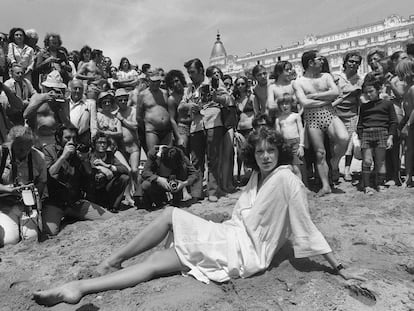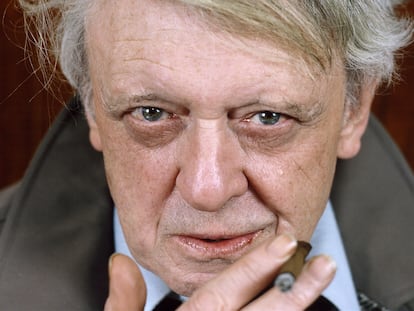Sean Connery in a loincloth? How ‘Zardoz’ became one of the strangest movies ever
Fifty years after its release, one of the most unclassifiable works of science fiction continues to divide opinions: while some see it is a failed epic with philosophical aspirations, to others it is a misunderstood masterpiece about conformism and violence
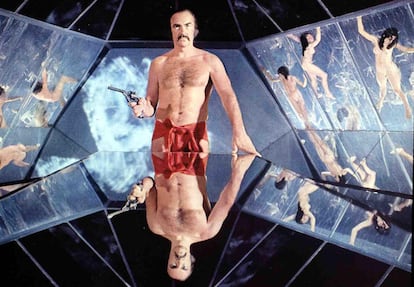

A mustache, a loincloth, a flying stone head and a few verses from Eliot. These were the ingredients chosen to create a classic of science fiction with intellectual undertones, the kind that was the norm before the triumphant arrival of Star Wars — even if not everyone would be willing to label a creation as peculiar as Zardoz, which is celebrating 50 years of existence (and controversy), a classic.
In February 1974, half a century ago, British filmmaker John Boorman went away to the Irish countryside to process the worst failure of his budding career. Zardoz, his first project after the international success of Deliverance (1972), had bombed at the box office despite its ample budget, a script he was particularly proud of and the presence of a Sean Connery in his prime.
What went wrong? According to prestigious critic Gene Siskel, practically everything, starting with the “narcissistic blindness” that led the English director to try to turn a perfectly trivial science fiction epic into a confusing exhortation to debauchery and a deranged apology for death. Boorman, in Siskel’s opinion, had contracted two of the worst cinematic diseases: self-indulgence and excess. To him, Zardoz was a narrative and esthetic fiasco.
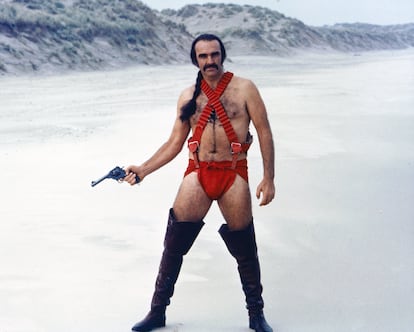
Fifty years later, Siskel’s opinion — as well as those of Pauline Kael, Jay Cocks, Roger Ebert and so many other professionals who hated the film and did nothing to hide their scorn — causes a certain bewilderment. We have grown used to considering Boorman’s work a cult film, a rarity for moviegoers with unprejudiced, empathetic palates, a discreet feast for minorities in the vein of Streets of Fire (Walter Hill, 1984), The Wicker Man (Robin Hardy, 1973), Big Trouble in Little China (John Carpenter, 1986) or The Man Who Fell to Earth (Nicolas Roeg, 1976). As critic Jonathan Rosenbaum would say, we are so postmodern that we have lost the habit of taking cinema literally, used as we are to interpretations with a skewed, condescending or ironic perspective, and Zardoz lends itself perfectly to such readings.
Boorman was not joking
Boorman’s intention was always for his movie to be taken seriously. He was aware that he was adding an outrageously high dose of countercultural kitsch and delirious esotericism to the mix, but that did not mean he did not have his sights set on Zardoz becoming a next evolutionary step in the type of “metaphysical” science fiction that had started with Stanley Kubrick’s 2001: A Space Odyssey.
Born in Shepperton, England, in January 1933 (he just turned 91), Boorman grew up compulsively reading books in the back room of a pub that was run by his parents, a middle-class couple with no higher education. When he was 20 years old, he enlisted in the British army, where he became an instructor and was almost sent to the Korean War.
His most memorable anecdote from his youth is that he was subjected to a court-martial for “fostering desertion and defeatism” among the soldiers he trained with his critical remarks about his country’s foreign policy and its shameful subordination to the American imperial project. In his defense, he argued that many of the opinions expressed in the barracks were based on articles from The Times, a respectable newspaper that could not be described as unpatriotic. He was acquitted.
After leaving the military life behind, he got a job in a laundry and began training as a television producer, first at Southern Television and later at the BBC. When he was 30 years old he released a successful documentary, Six Days to Saturday (1962), focused on the daily routines of a soccer club, Swindon Town, in the English Second Division at the time.
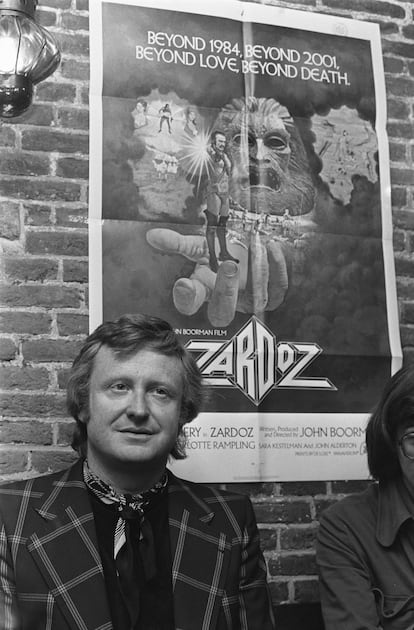
Catch Us If You Can (1965), a strange and suggestive vehicle for the pop band Dave Clark Five, was his first feature film. Then came Point Blank (1967), an elegant, amoral thriller, starring a splendid Lee Marvin as a hired hitman with a paradoxical sense of justice, and Hell in the Pacific, again starring Marvin.
At 35 years old and with just three films under his belt, Boorman had already built a solid reputation as a versatile professional with good taste. United Artists offered him the opportunity to embark on his first auteur project, working on his own script and with hardly any creative interference. He did the very well-regarded Leo the Last (1970), a tribute to the cinema of Federico Fellini with Marcello Mastroianni in the role of an idle heir who tries to intervene, with better intentions than judgment, in the lives of the inhabitants of a modest London neighborhood. He won the award for Best Director at the Cannes Festival and, with it, got carte blanche to embark on even more personal projects.
The unsettling Deliverance, where Jon Voight, Burt Reynolds and Ned Beatty canoe down a river into the fiercest hell of rural America, showed that he was capable of combining critical prestige with box office success. Although it obtained three (unsuccessful) Oscar nominations, the $46 million that it grossed was, as he himself admitted a few years later, his best endorsement; the blank check that elevated him to the ranks of the industry’s leading figures.
How to squander your reputation in two movies
In 1972 he turned his back on Warner Bros., the distributor of Deliverance, to sign an even more lucrative contract with 20th Century Fox. Shortly before, he had been close to reaching an agreement with United Artists to embark on a pharaonic adaptation of The Lord of the Rings, destined, from his point of view, to bring to light the entire metaphysical substratum of Tolkien’s work and turn it into a cinematographic spectacle “that made people think.”
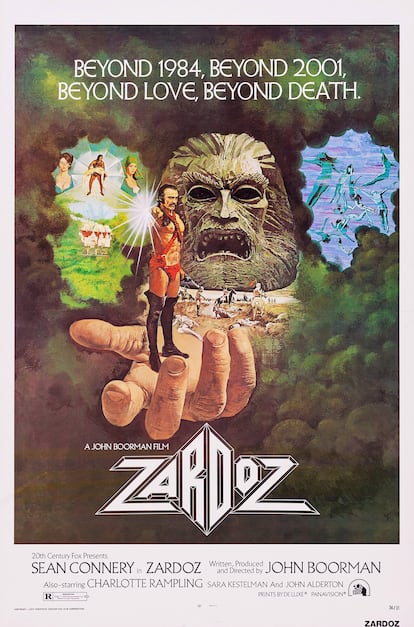
That desire to set a story of broad intellectual significance in a fantasy environment would end up crystallizing in Zardoz, a script written jointly with his old friend Bill Stair. Inspired by the mystical poetry of TS Eliot, the cycle of Arthurian legends and the youth literature of Frank L. Baum (The Wonderful Wizard of Oz), Boorman and Stair envisioned a late 23rd-century Earth that had been devastated by a nuclear catastrophe and where two species of human survivors coexisted: the Eternals, a superior caste confined to an idyllic setting (the Vortex, the only truly habitable area on the planet) to whom science had granted immortality, and the Apathetics, who had been reduced to a precarious, troglodytic existence in a vast wasteland known as the Outlands.
The Fox executives were not particularly enthusiastic about the script, but they decided to trust Boorman, who seemed to be in a state of grace and who, besides, had guaranteed them that Burt Reynolds, one of the stars of the moment, was going to be the lead actor. The whole operation came close to derailing when Reynolds decided to reject the role of Zed, leader of the Apathetics and alleged messiah of this dystopian universe, citing scheduling problems, but guided, in reality, by his instinct and the opinion of his agent, as they were not sure that such a complicated film would end up becoming a success.
After a tense period of waiting, a stroke of luck made all the pieces fit together: Connery, who was just coming out of his ten-year stint in the James Bond series with Diamonds Are Forever (1971), was looking for new acting challenges and was eager to work with Boorman. In truth, however, the then 42-year-old Scottish actor would have worked with anyone who was willing to hire him. After a short sabbatical, he was feeling the perverse effects of his long association with the secret agent: now the world found it hard to picture him in any other role. Driven by this fear of extreme typecasting, Connery accepted the role that Boorman offered him, hardly even thinking about it, even if it involved such onerous concessions as growing a biker mustache or donning a speedo-ish loincloth with crossed suspenders that would become the most memorable image of the film as well as a source of ridicule, even today.
The film was shot in the Republic of Ireland, at Ardmore Studios, in Bray, near Dublin, as well as in several surrounding locations. Boorman was also able to get hold of another famous actress, Charlotte Rampling, who would soon release the film that would finally establish her, The Night Porter (1974).
A series of minor inconveniences surrounded the shoot, such as protests by locals over the nude scenes that were filmed outdoors or the strict control imposed by Ireland on the importation of firearms, a consequence of the activities of the IRA. Still, it was a mostly placid production process, thanks to Boorman’s relaxed, easygoing style. Settled in Bray, Connery enjoyed the feeling of being apart from the world, the small everyday pleasures and his return to acting, with the exhausting circus that the Bond films had become now behind him.
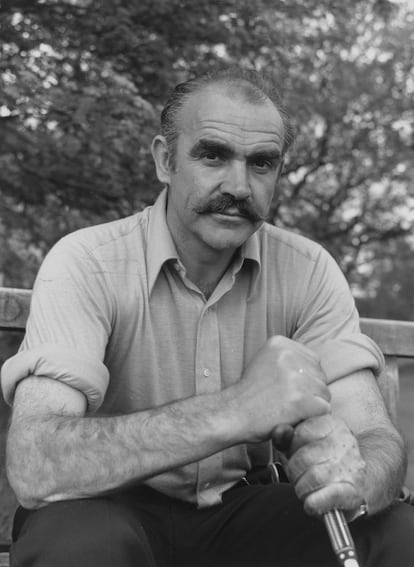
Afterwards, things moved quickly, in a very intense post-production process that involved the composition of an avant-garde score (“genuine 23rd century music,” Boorman would say) by David Munrow from the Early Music Consort of London. The discretionary use of Beethoven’s Symphony No. 7 completed an acoustic landscape that Boorman intended to be “overwhelming.”
The film was released in the winter of 1974, a year of great box office hits such as Blazing Saddles, The Towering Inferno, Airport 1975 and Young Frankenstein, and it did not have, by any means, the expected impact. Even worse: it became the object of ridicule and parody. Connery’s loincloth and bare, hairy chest did not go unnoticed.
Kyle Anderson, an expert in cult cinema, considers it shocking that Boorman was handed nearly $2 million to spend with impunity on a film as crazy, delusional and proudly kitsch as this one, although he admits that the movie does have some fortunate achievements, such as the Zardoz that gives it its title, the giant stone head that flies over the Outlands and is revered by the most violent faction of the Apathetics, a group of murderers who exterminate their fellow humans like vermin under the slogan of: “The gun is good. The penis is evil.”
The message, in Anderson’s opinion, is nothing but disconcerting gibberish, a hymn to life and a fierce invitation to avoid the conformity and apathy that translates into demented mysticism, irrational violence and morbid, uncomfortable sex. Ingredients, in short, completely misunderstood in their time, but which today give rise to a retrospective cult that has expanded its aura.
After his spiritual retreat in Ireland, once the wounds that this epic failure left in his ego had healed, Boorman would sink even lower by making the sequel to The Exorcist, (Exorcist II: The Heretic, 1977), a film that even he himself hates, before recovering his credibility with the amazing — and ultimately vacuous — Excalibur (1981).
Years later, the director would say that, for him, Zardoz had been a “school of failure” and a lesson in humility. “When you feel on top of the world, that’s when you’re most likely to tumble,” he declared. However, to his immense luck, there is no failure that cannot become an object of worship if it features mythic ammunition of the caliber of a Connery cavorting half-naked with a gun in his hand or a gigantic flying head hovering over a sinister fantasy wasteland.
Sign up for our weekly newsletter to get more English-language news coverage from EL PAÍS USA Edition
Tu suscripción se está usando en otro dispositivo
¿Quieres añadir otro usuario a tu suscripción?
Si continúas leyendo en este dispositivo, no se podrá leer en el otro.
FlechaTu suscripción se está usando en otro dispositivo y solo puedes acceder a EL PAÍS desde un dispositivo a la vez.
Si quieres compartir tu cuenta, cambia tu suscripción a la modalidad Premium, así podrás añadir otro usuario. Cada uno accederá con su propia cuenta de email, lo que os permitirá personalizar vuestra experiencia en EL PAÍS.
¿Tienes una suscripción de empresa? Accede aquí para contratar más cuentas.
En el caso de no saber quién está usando tu cuenta, te recomendamos cambiar tu contraseña aquí.
Si decides continuar compartiendo tu cuenta, este mensaje se mostrará en tu dispositivo y en el de la otra persona que está usando tu cuenta de forma indefinida, afectando a tu experiencia de lectura. Puedes consultar aquí los términos y condiciones de la suscripción digital.
More information
Archived In
Últimas noticias
Maduro pleads not guilty before the federal court in New York: ‘I am still the president of Venezuela’
A new test can detect Alzheimer’s from a finger prick
UN team enters Sudanese city of El Fasher after paramilitary massacre: ‘It’s like a ghost town’
A recipe for resistance: Indigenous peoples politicize their struggles from the kitchen
Most viewed
- Gilles Lipovetsky: ‘If you want to live better and fall in love, take Prozac, don’t look to philosophy’
- Alain Aspect, Nobel laureate in physics: ‘Einstein was so smart that he would have had to recognize quantum entanglement’
- Alvin Hellerstein, a 92-year-old judge appointed by Bill Clinton, to preside over Maduro’s trial in New York
- Why oil has been at the center of Venezuela-US conflicts for decades
- Maduro’s downfall puts China’s relationship with Venezuela to the test
